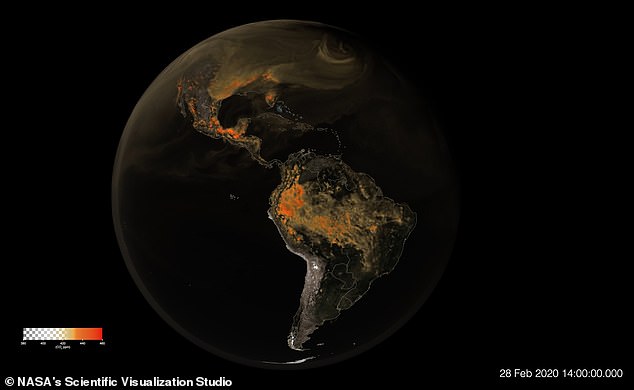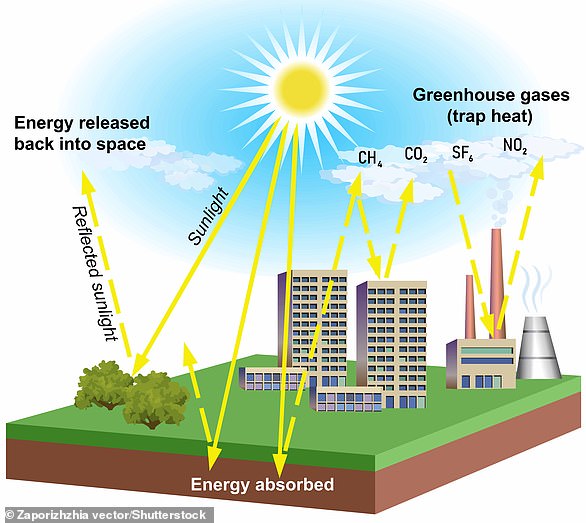The greenhouse gases swirling above our heads: NASA captures footage of CO2 churning in the sky – with huge plumes coming from power plants and forest fires
It is the most abundant greenhouse gas and is causing alarming global warming.
Now, incredible new images have emerged showing the roiling levels of carbon dioxide (CO2) that are fueling climate change.
NASA satellites have spotted swirls of gas coming from power plants, wildfires, livestock raised for meat, and more.
CO2 is of course invisible, but experts at NASA’s Scientific Visualization Studio have turned it bright orange so it can be clearly seen.
In the clip, the gas is seen in mesmerizing ‘pulses’ as the world turns and day turns to night.
NASA video shows carbon dioxide concentrations as the gas moved through Earth’s atmosphere from January through March 2020
“As policymakers and scientists, we’re trying to figure out where carbon comes from and what impact it has on the planet,” said climate scientist Lesley Ott of NASA’s Goddard Space Flight Center in Greenbelt, Maryland.
‘You see here how everything is connected by these different weather patterns.’
Satellites in space are equipped with instruments called spectrometers, which detect and monitor greenhouse gases such as CO2.
NASA’s global map shows the concentrations of CO2 as the gas moved through Earth’s atmosphere between January and March 2020, driven by wind patterns and atmospheric circulation.
If you zoom in on the video, you will see emissions from power plants, fires and cities rise and then spread across continents and oceans.

The more intense emissions (with higher intensity of CO2 molecules) appear as a deeper reddish-orange color

Carbon dioxide (CO2) is a heat-trapping greenhouse gas and the primary reason for rising global temperatures. As CO2 builds up in the atmosphere, it warms our planet
During that period, the majority of emissions from China, the US and South Asia came from power plants, industrial facilities and vehicles.
In Africa and South America, most CO2 emissions came from fires, especially those associated with land management, controlled agricultural fires and deforestation, but also from the burning of fossil fuels such as oil and coal.
Trees absorb CO2 from the air and store it. When burned, a large amount of gas is released.
In the video, CO2 appears in ‘pulses’, which is largely due to polluting human activities that occur mainly during the day.
For example, wildfires usually flare up during the day and die out at night, and most vehicles (which emit CO2 through their exhausts) also drive during the day.

As the world turns, the gas appears in mesmerizing “pulses” as day turns to night. Of course, CO2 is invisible, but experts at NASA’s Scientific Visualization Studio have turned it bright orange to make it easy to see
Of course, CO2 is not the most powerful greenhouse gas. That is methane (CH4), which is created by the combustion of fossil fuels, the decomposition of landfill waste and much more.
According to scientists, methane has a warming potential 28 times greater than that of CO2. Fortunately, it is not released as much as CO2.
Scientists generally agree that the Earth is heading for climate disaster because humans are failing to sufficiently reduce emissions.
They believe that eventually the planet will become too warm due to global warming, leading to widespread heat exhaustion and death, flooding of coastal cities due to polar ice accumulation, and food shortages.
United Nations Secretary-General Antonio Guterres said we are “heading towards climate hell, with our foot on the accelerator.”

